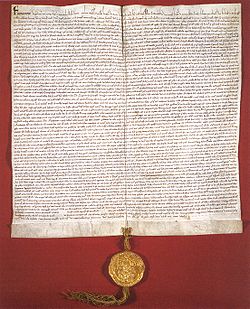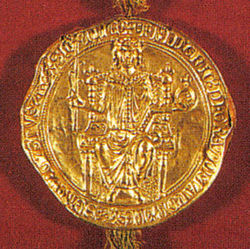
Golden Charter of Bern
Encyclopedia

Golden Bull
A Golden Bull or chrysobull was a golden ornament representing a seal , attached to a decree issued by Byzantine Emperors and later by monarchs in Europe during the Middle Ages and Renaissance. The term was originally coined for the golden seal itself but came to be applied to the entire decree...
, in German
German language
German is a West Germanic language, related to and classified alongside English and Dutch. With an estimated 90 – 98 million native speakers, German is one of the world's major languages and is the most widely-spoken first language in the European Union....
: Goldene Handfeste or Berner Handfeste) is a medieval charter
Charter
A charter is the grant of authority or rights, stating that the granter formally recognizes the prerogative of the recipient to exercise the rights specified...
purporting to have been issued by Holy Roman Emperor
Holy Roman Emperor
The Holy Roman Emperor is a term used by historians to denote a medieval ruler who, as German King, had also received the title of "Emperor of the Romans" from the Pope...
Frederick II
Frederick II, Holy Roman Emperor
Frederick II , was one of the most powerful Holy Roman Emperors of the Middle Ages and head of the House of Hohenstaufen. His political and cultural ambitions, based in Sicily and stretching through Italy to Germany, and even to Jerusalem, were enormous...
. It establishes the town privileges
Town privileges
Town privileges or city rights were important features of European towns during most of the second millennium.Judicially, a town was distinguished from the surrounding land by means of a charter from the ruling monarch that defined its privileges and laws. Common privileges were related to trading...
of Bern (now the capital of Switzerland
Switzerland
Switzerland name of one of the Swiss cantons. ; ; ; or ), in its full name the Swiss Confederation , is a federal republic consisting of 26 cantons, with Bern as the seat of the federal authorities. The country is situated in Western Europe,Or Central Europe depending on the definition....
), making it an Imperial Free City and, effectively, an independent
Independence
Independence is a condition of a nation, country, or state in which its residents and population, or some portion thereof, exercise self-government, and usually sovereignty, over its territory....
state. The charter is dated to 1218, but is now believed by most scholars to be a Bernese forgery from the middle of the 13th century.
The charter's 54 articles provided for extensive privileges, including the free election of the Schultheiss (i.e., mayor
Mayor
In many countries, a Mayor is the highest ranking officer in the municipal government of a town or a large urban city....
) and the right to autonomously legislate. It also provided for the establishment of an Imperial Mint
Mint (coin)
A mint is an industrial facility which manufactures coins for currency.The history of mints correlates closely with the history of coins. One difference is that the history of the mint is usually closely tied to the political situation of an era...
, which was established in 1228 at the latest, to coin Berner Pfennig
Pfennig
The Pfennig , plural Pfennige, is an old German coin or note, which existed from the 9th century until the introduction of the euro in 2002....
e. These rights were formally confirmed by King Rudolf I
Rudolph I of Germany
Rudolph I was King of the Romans from 1273 until his death. He played a vital role in raising the Habsburg dynasty to a leading position among the Imperial feudal dynasties...
in 1274, and the issue of the charter's authenticity thus made moot. The charter is called "golden" due to its impressive (and undoubtedly authentic) golden bull, or seal
Seal (device)
A seal can be a figure impressed in wax, clay, or some other medium, or embossed on paper, with the purpose of authenticating a document ; but the term can also mean the device for making such impressions, being essentially a mould with the mirror image of the design carved in sunken- relief or...
. Its face shows Frederick on the throne with his Emperor's regalia
Regalia
Regalia is Latin plurale tantum for the privileges and the insignia characteristic of a Sovereign.The word stems from the Latin substantivation of the adjective regalis, 'regal', itself from Rex, 'king'...
, circumscribed "Frederick, by the Grace of God Roman King, ever increasing the Empire, King of Sicily."

X-ray
X-radiation is a form of electromagnetic radiation. X-rays have a wavelength in the range of 0.01 to 10 nanometers, corresponding to frequencies in the range 30 petahertz to 30 exahertz and energies in the range 120 eV to 120 keV. They are shorter in wavelength than UV rays and longer than gamma...
analysis in 2002 did not reveal any indication that (as had been assumed) the authentic bull had been removed from an authentic document and then re-affixed to the Bernese charter.
Literature
- Rainer C. Schwinges, Erfolgreich gefälscht — die Goldene Handfeste in: Rainer C. Schwinges (ed.), Berns mutige Zeit: Das 13. und 14. Jahrhundert neu entdeckt, Bern, Schulverlag blmv AG und Stämpfli Verlag AG, Bern 2003, ISBN 3-292-00030-0 and ISBN 3-7272-1272-1, p. 231–232.
- Barbara Spalinger, Die Goldbulle der Handfeste im Röntgenbild, in: Schwinges (2003), op.cit., p. 233.
- Karl H. Flatt, Das Bernbiet im Früh- und Hochmittelalter, in: Peter Meyer (ed.), Berner — deine Geschichte, Büchler Verlag, Bern 1981, ISBN 3-7170-0185-X, p. 58.

